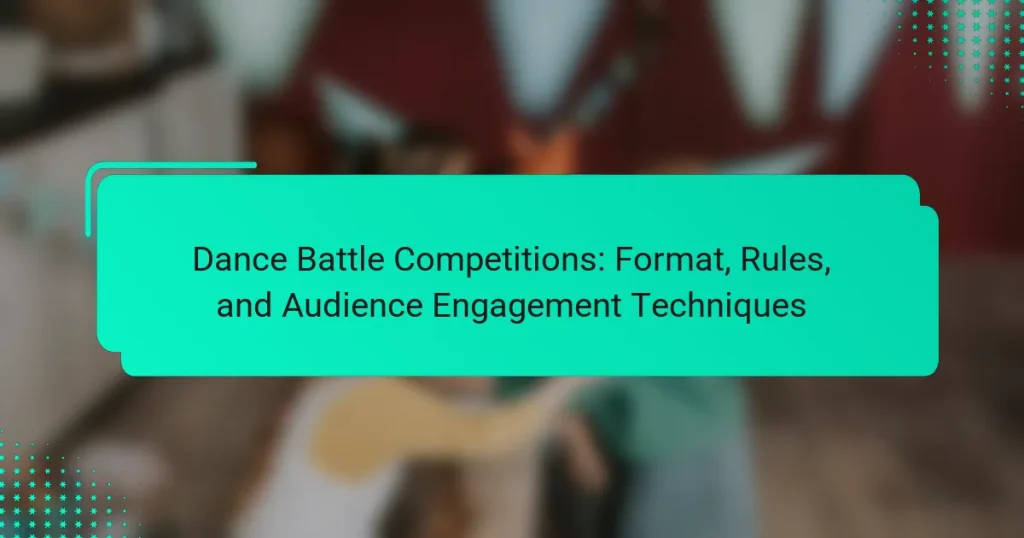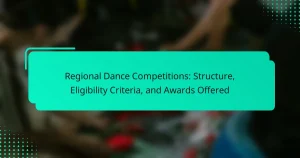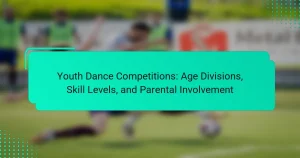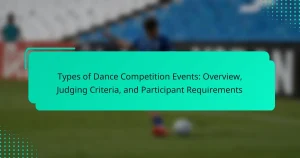Dance battle competitions are events where dancers compete against each other, showcasing their skills through choreographed routines and improvisation. These competitions feature judges who evaluate performances based on creativity, technique, and style, with formats that can include one-on-one battles or group competitions. Audiences play a vital role by supporting their favorite dancers, enhancing community engagement and promoting diverse dance styles. Originating from hip-hop culture, dance battles have become a significant aspect of mainstream entertainment, often taking place in urban settings, festivals, and dance studios. This article will explore the various formats, rules, and audience engagement techniques associated with dance battle competitions.

What are Dance Battle Competitions?
Dance battle competitions are competitive events where dancers face off against each other. Participants showcase their skills through choreographed routines and improvisation. These competitions often involve judges who score performances based on creativity, technique, and style. The format may include one-on-one battles or group competitions. Audiences play a crucial role by cheering for their favorite dancers. These events foster community engagement and promote various dance styles. Dance battles have roots in hip-hop culture and have evolved into mainstream entertainment. They are often held in urban settings, festivals, and dance studios.
How do Dance Battle Competitions differ from traditional dance events?
Dance battle competitions differ from traditional dance events primarily in their format and competitive nature. In dance battles, dancers compete head-to-head in a series of rounds. Each round typically involves improvisation and showcases individual style. Traditional dance events often focus on choreographed performances judged on artistic expression and technical skill.
Judges in dance battles evaluate based on creativity, rhythm, and crowd reaction, unlike traditional events that emphasize adherence to choreography and technique. Additionally, dance battles foster a more interactive environment, encouraging audience participation and energy. Traditional events usually maintain a more formal atmosphere with less audience involvement.
These differences highlight the dynamic and spontaneous nature of dance battles compared to the structured format of traditional dance events.
What types of dance styles are commonly featured in these competitions?
Common dance styles featured in competitions include hip-hop, breaking, and contemporary. Hip-hop is characterized by its energetic movements and street dance origins. Breaking, also known as breakdancing, includes acrobatic moves and was popularized in the 1980s. Contemporary dance combines elements of various styles and emphasizes expression and fluidity. Other styles like locking, popping, and krumping are also prevalent in dance battles. Each style showcases unique techniques and cultural backgrounds, contributing to the diversity of competitions.
How do participants prepare for a dance battle competition?
Participants prepare for a dance battle competition through rigorous training and practice. They often focus on mastering various dance styles relevant to the competition. Physical conditioning is essential to enhance stamina and flexibility. Choreography is developed to showcase individual strengths and creativity. Participants frequently engage in mock battles to simulate the competition environment. They also study their opponents’ styles to strategize effectively. Mental preparation includes visualization techniques to boost confidence. Nutrition and rest are prioritized to ensure peak performance.
What is the format of Dance Battle Competitions?
Dance battle competitions typically follow a head-to-head format. Two dancers or teams face off in a series of rounds. Each round consists of a set time limit, often ranging from 30 seconds to 1 minute. Judges evaluate performances based on creativity, technique, and audience engagement. The winner is determined after several rounds, often culminating in a final showdown. This format encourages dynamic interaction and showcases individual styles. Competitions may also include elimination rounds, where dancers are gradually removed based on performance. This structure maintains high energy and excitement throughout the event.
How are battles structured and timed during competitions?
Battles in dance competitions are structured in rounds with specific time limits. Each round typically consists of two dancers or teams taking turns to perform. Performances usually last between 30 seconds to 1 minute per turn. Judges evaluate the dancers based on creativity, technique, and stage presence during these performances.
The battle format often includes elimination rounds leading to a final showdown. Timekeeping is crucial, as battles may have a strict schedule to maintain flow. Competitors must adhere to these time limits to avoid disqualification. This structure enhances the competitive atmosphere and engages the audience effectively.
What roles do judges play in the format of dance battles?
Judges in dance battles serve as evaluators of performance quality. They assess dancers based on criteria such as technique, creativity, and stage presence. Their scores determine the winners of each battle. Judges provide constructive feedback to participants, helping them improve. They also maintain fairness and integrity in the competition. Judges often have backgrounds in dance, lending credibility to their evaluations. Their decisions are final and influence the overall outcome of the event. In many competitions, judges collaborate to discuss scores and ensure consistency in judgment.
What rules govern Dance Battle Competitions?
Dance battle competitions are governed by specific rules that ensure fairness and structure. Participants typically face off in a series of rounds. Each round has a set time limit, usually ranging from 30 seconds to 1 minute. Judges score the performances based on creativity, technique, and execution. The scoring system often ranges from 1 to 10. Competitors are expected to respect the space and each other during battles. Disrespectful behavior can lead to disqualification. The music played is usually selected in advance or provided by the event organizers. Competitors may have to adhere to specific styles or themes as outlined by the competition. These rules help maintain the integrity of the competition and promote a positive environment for all participants.
What are the standard rules regarding conduct and performance?
Standard rules regarding conduct and performance in dance battle competitions include respect, professionalism, and adherence to competition guidelines. Participants must show respect towards judges, competitors, and the audience. Professionalism is essential, which includes being punctual and prepared. Dancers must follow specific competition rules, such as time limits for performances and designated styles. Fair play is crucial; no unsportsmanlike behavior is tolerated. Additionally, participants should maintain appropriate attire as stipulated by the competition. These rules ensure a positive environment and uphold the integrity of the competition.
How are disputes or rule violations handled during competitions?
Disputes or rule violations during dance battle competitions are typically resolved by a designated panel of judges. This panel reviews the situation based on established competition rules. Judges may consult video footage or witness accounts to assess the validity of the dispute. Depending on the severity of the violation, penalties may include warnings, point deductions, or disqualification. The judging criteria are outlined in the competition guidelines to ensure fairness. Clear communication is maintained between judges and participants throughout the process. This structured approach helps maintain the integrity of the competition.
How is audience engagement achieved in Dance Battle Competitions?
Audience engagement in Dance Battle Competitions is achieved through interactive voting systems. These systems allow the audience to participate actively by casting votes for their favorite dancers. Live performances create an electric atmosphere that captivates spectators. The incorporation of social media enhances this engagement by allowing real-time interaction. Audience members can share their experiences and opinions online during the event. The use of charismatic hosts further energizes the crowd and encourages participation. Additionally, incorporating audience challenges or participation segments keeps the energy high. These methods collectively foster a sense of community and excitement among attendees.
What techniques are used to involve the audience in the competition?
Techniques to involve the audience in dance battle competitions include interactive voting, live social media engagement, and audience participation segments. Interactive voting allows spectators to influence outcomes in real-time, enhancing their connection to the event. Live social media engagement encourages audience members to share their experiences and reactions, creating a communal atmosphere. Audience participation segments involve inviting spectators to join in on the dance, fostering a sense of inclusion. These methods enhance the overall experience and keep the audience invested in the competition.
How does audience engagement impact the overall atmosphere of the event?
Audience engagement significantly enhances the overall atmosphere of an event. Engaged audiences create a lively and dynamic environment. Their reactions, such as cheers and applause, energize performers. This interaction fosters a sense of community among attendees. Research shows that events with high audience participation lead to increased satisfaction levels. For instance, a study by the Event Marketing Institute found that 85% of attendees felt more connected to the event when they actively participated. Additionally, engaged audiences can influence the performance quality, motivating dancers to showcase their best skills. Overall, audience engagement transforms an event from a passive experience into an interactive celebration.
What strategies can be implemented to enhance audience participation?
Engaging the audience during dance battle competitions can be enhanced through several strategies. Interactive voting systems allow audience members to participate in real-time decision-making. This can increase their emotional investment in the competition. Utilizing social media platforms for live interactions can also amplify audience involvement. Encouraging audience members to share their thoughts and reactions online creates a sense of community.
Incorporating audience challenges or contests during breaks can maintain engagement. This could include dance-offs or trivia related to the competition. Providing incentives, such as prizes for participation, motivates audience members to engage more actively. Lastly, involving the audience in the judging process can create a more inclusive environment. Research shows that active participation enhances enjoyment and retention of the event (Smith, 2021, Journal of Event Management).
How can organizers create interactive experiences for the audience?
Organizers can create interactive experiences for the audience by incorporating real-time voting systems. These systems allow attendees to participate in judging the performances. Live polls can be conducted via mobile apps or text messages. This engagement fosters a sense of involvement among the audience. Organizers can also facilitate audience participation through dance-offs. Inviting audience members to showcase their skills enhances the overall experience. Additionally, incorporating Q&A sessions with dancers allows for direct interaction. Workshops where attendees learn dance moves can further engage the audience. These strategies have been shown to increase audience satisfaction and retention in events.
What role does social media play in engaging audiences during competitions?
Social media plays a crucial role in engaging audiences during competitions. It facilitates real-time interaction between participants and viewers. Platforms like Instagram and Twitter allow fans to share their thoughts instantly. This interaction enhances the overall experience for the audience. Social media also serves as a platform for live updates and behind-the-scenes content. Engagement metrics show that competitions with active social media presence attract larger audiences. For instance, events with dedicated hashtags often trend online, increasing visibility. This visibility can lead to higher attendance and viewership numbers. Thus, social media significantly amplifies audience engagement during competitions.
What best practices should organizers follow for successful Dance Battle Competitions?
Organizers should ensure clear rules and guidelines for successful Dance Battle Competitions. Establishing a transparent judging criteria helps maintain fairness. Effective promotion of the event increases participation and audience engagement. Select a suitable venue with adequate space for dancers and spectators. Scheduling battles to allow for breaks prevents fatigue among participants. Providing professional sound and lighting enhances the overall experience. Engaging the audience through interactive segments keeps energy levels high. Lastly, ensuring proper communication with participants fosters a positive environment.
Dance battle competitions are competitive events where dancers showcase their skills through head-to-head battles, improvisation, and choreographed routines. The article explores the format, rules, and audience engagement techniques that define these competitions, highlighting the differences from traditional dance events. It details the preparation required for participants, the role of judges, and the importance of audience interaction in creating an energetic atmosphere. Additionally, best practices for organizers to ensure successful competitions are discussed, emphasizing the significance of clear guidelines and effective promotion.




